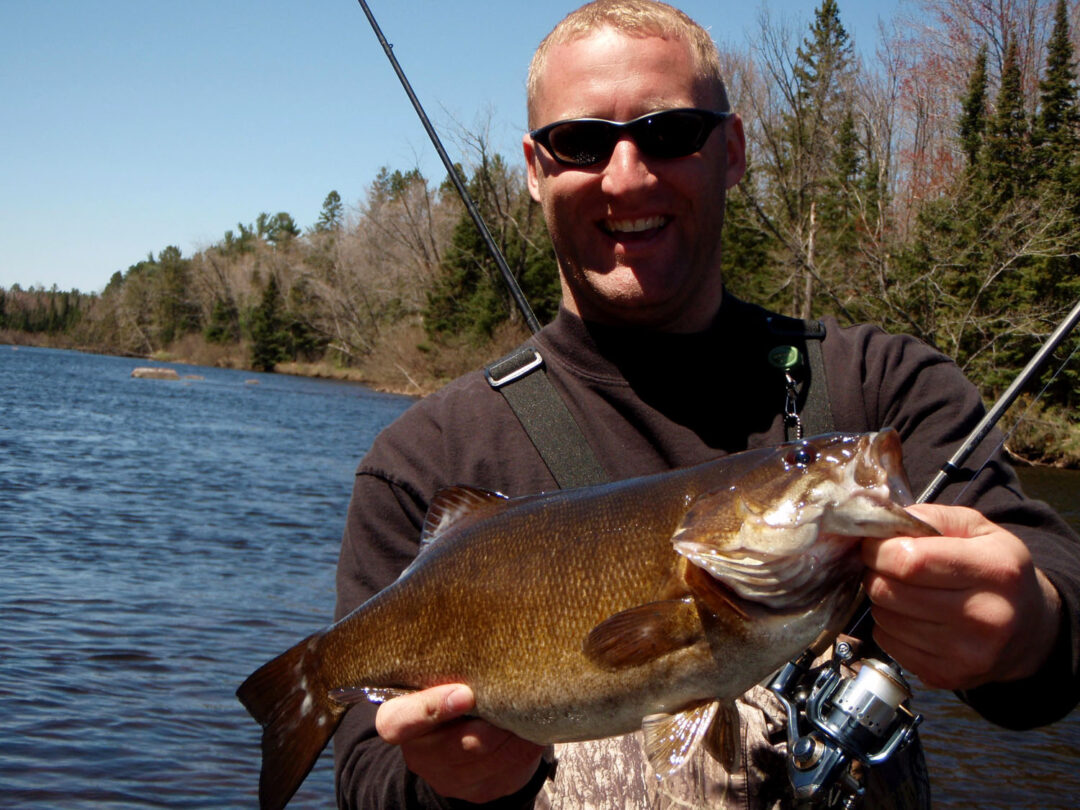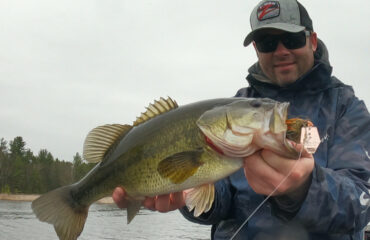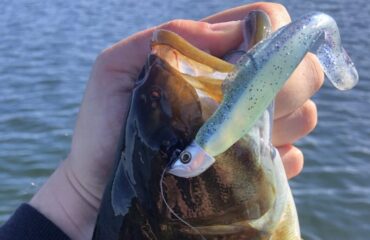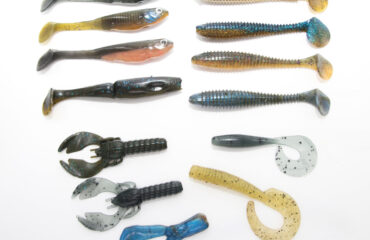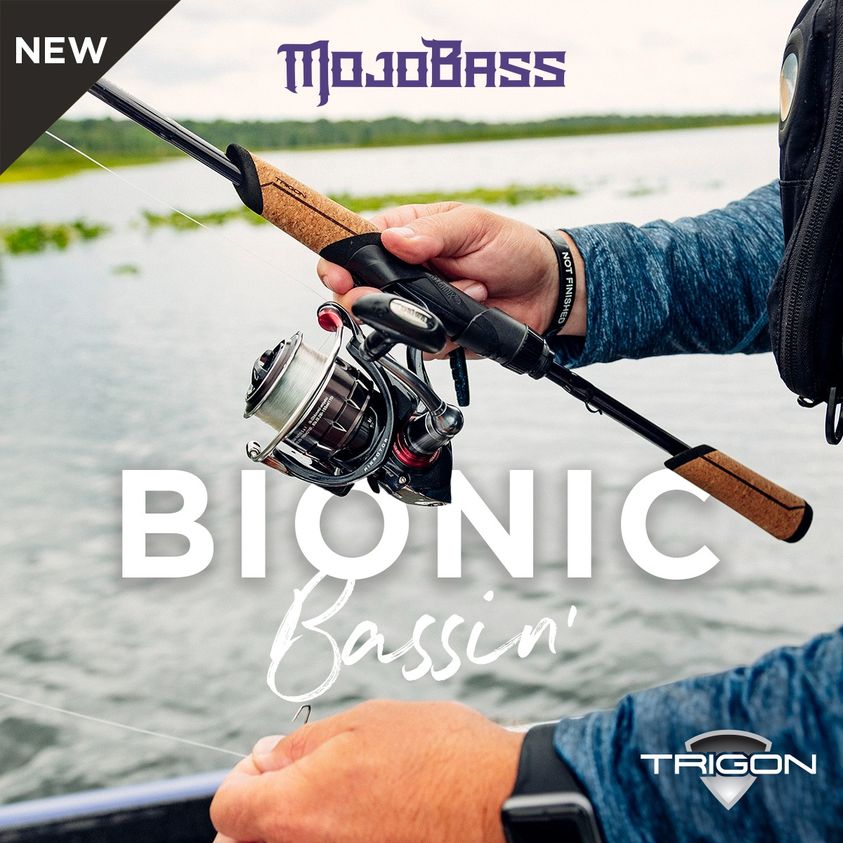Small Streams, Big Bass
By Andrew Ragas
We fish our flowing waters by wading, kayaking, bank fishing or floating them with small craft. At some point in our angling careers, we likely cut our teeth on fishing small rivers and streams due to their availability, affordability, aesthetics, and convenience to fish.
During my money-less and boat-less days of youth, rivers and streams were my only practical options for quality bass fishing. Many of them were local, easy and moderate to access, untapped for the most part, and the gear requirements to effectively fish them didn’t cost much. Several years later, as my fishing has evolved to bigger and better things, rivers and streams drastically became less fished destinations. Nowadays as I tend to gravitate most to world class waters, and travel to renowned destinations by truck and boat, small stream are still occasionally fished.
Small rivers and streams are the most overlooked and ignored aspects in bass fishing. They are the roads less traveled. Their angling takes place at venues you’ve likely driven over hundreds or thousands of times, or passed by along roadsides. Unless your earliest angling memories involve wading or shore fishing them from public access sites, parks, and dams, you might not have ever considered these little gems to be worthy of your time.
Having taught me the most important lessons and subjects I know about smallmouth fishing, small streams will always be special fisheries. The adventure, isolation, productivity, and big bass possibilities they can provide are the biggest draw, and allure.
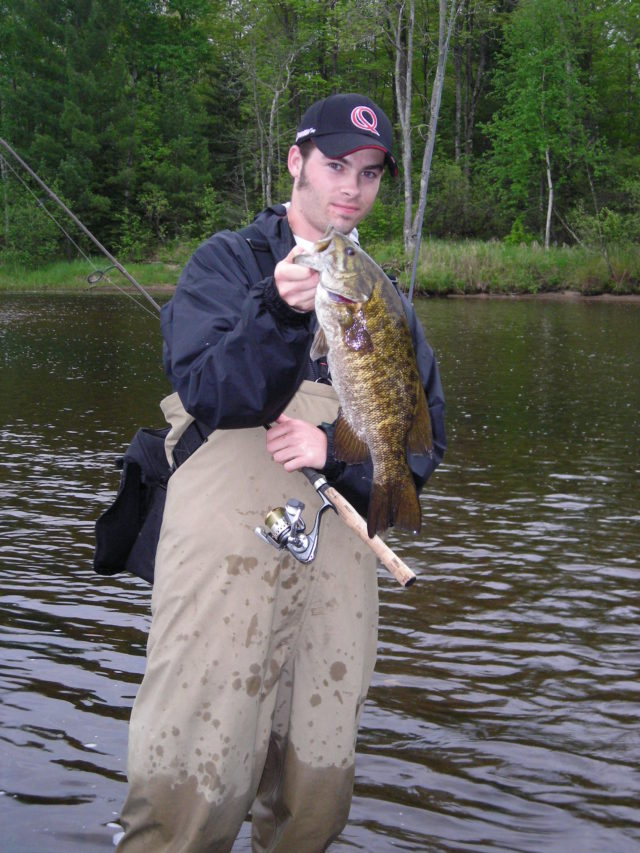
This fish is my largest stream smallmouth caught by wading, 2008. Just after when I bought my first boat…… and became boat dependent for most of my river fishing activities.
Home to Big Smallmouth, not just Minnows
Throughout the smallmouth bass range, and on every map, small rivers and creeks wind and meander their way around the landscape. They supply nutrients and fertility to the land, and support diverse aquatic life and fish species. Some are located in urban areas, and others are in remote regions further away from civilization. When located off the beaten path, they can provide exciting untapped angling and opportunity for big bass.
Good water quality dictates the health and status of the fishery. If you’ve always thought small streams are only home to small fish such as minnow species and juvenile gamefish, you are mistaken. To your surprise, many small rivers and creeks hold big fish potential, just not an abundance of them. While small streams have limitations such as the “fish bowl theory”, the possibility of big bass becomes exponentially greater if the small stream is a tributary of a larger river system. In these inter-connected waterways smallmouth are known to seasonally migrate back and forth for spawning and feeding, assuming there aren’t barriers such as dams. These streams will be home to seasonal migrant fish and year round resident fish if deep wintering holes are available.
Few serious bass anglers will ever realize the potential of these little fisheries and the big smallmouth they can hold. While most streams will limit the top end growth of its bass, some of them are capable of producing a trophy fish or two. Because of a small stream’s limitations in fertility and growth rates, many fishermen are completely oblivious of their trophy potential.
For example, small streams are capable of producing some heavyweights. During my teenage years while growing up in Illinois, my largest ever smallmouth was caught from a small tributary of the Illinois River watershed in Chicago’s western suburbs; a 19 incher weighing 4 lbs. Meanwhile in Wisconsin, I have caught several robust, quality 18 to 20” (and larger) specimens to date from tributaries and streams of both the vast Wisconsin River and Chippewa River systems. As I mention, the probability and eventual sustainability of big smallmouth residing in small streams like these fisheries is very high if their little trickles and flows eventually merge into a much larger river system where most fish can originate from.
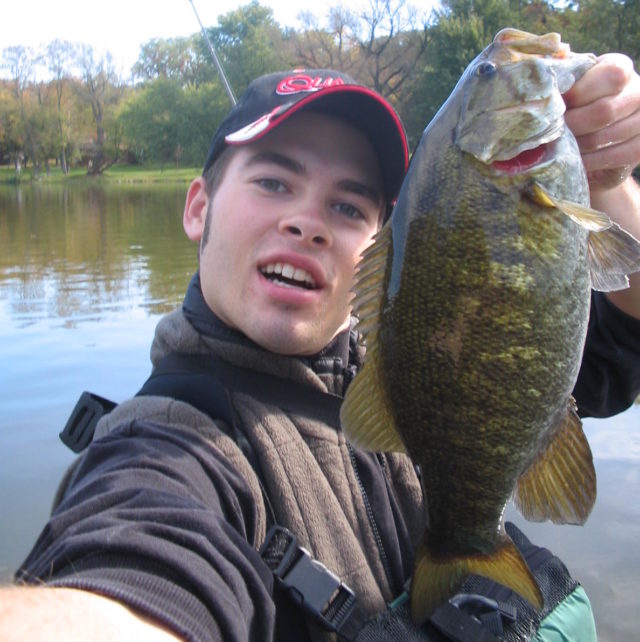
Small streams are capable of producing some heavyweights. During my teenage years while growing up in Illinois, my largest ever smallmouth was caught from a small tributary of the Illinois River watershed in Chicago’s western suburbs; a 19 incher weighing 4 lbs.
On these small streams smallmouth tend to migrate long distances from one season to the next, unless one short segment of river can provide all of their year-round needs. This includes spawning habitat, deep wintering holes, shallow rocky riffles providing mid-summer oxygenation, other habitats, and necessary food sources such as crayfish and minnow species to keep fish healthy and growing.
Typical features and smallmouth habitats of small streams include fast runs and slow runs (troughs), gravel bars, riffles, weed beds, log jams, and pools. Man made areas that include bridges and rip-rap banks are other points of attraction as well. Smallmouth relate to it all depending on time of season and where primary food sources are located.
Although most small streams are usually slower gradient, many of them have mid-stream obstructions which form fast runs of current. These areas are shallow to mid depth, and shoot into pools of deeper water. On these streams, shallow can be just inches deep, while anything deep is considered to be greater than waist-high depth. On my northern streams, these stretches lead from one pool to another, and migrating bass use them as passageways. They are filled with rock of all sizes which form current breaks and temporary feeding areas.
Slow runs can be shallow also, but most of them are deeper with the slowest gradient current. In most small rivers I fish, these areas are lined with mid-current eelgrass beds, which are a nuisance to anglers and watercraft, but beneficial to smallmouth as important mid-summer feeding areas. In slow runs, and especially pools, laydowns and log jams are common near-shore pieces of cover that smallmouth will use often. The best wood will be anchored into the river bottom, and have openings in between branches or arms for bass to ambush prey.
Many of the best smallmouth streams feature rock habitat and an abundance of gravel bars that lead to riffles. Rocks are important because crayfish, their primary staple, will be found there. These rocks are also important because if you’ve learned to read the water, the riffles they form are the most obvious signs of structure and underwater contour of a river. Riffles are the most important areas of a small stream because they mix oxygen into the water and are critical for comfort and survival. These areas are shallow, fast water areas with too much current for bass to hold in. But the current breaks their rock and boulders form, and deeper pools they immediately drop into can be fish holding areas year-round. These pools can have current breaks and eddies anywhere within, and encompass habitat of other kinds making them the most attractive spot in every river for smallmouth that can be used for spawning and homing year round. Additionally, any sizeable pool could also have the greatest depth of the river, possibly for wintering, further enhancing its year-round productiveness and attractiveness to all fish species of the stream.
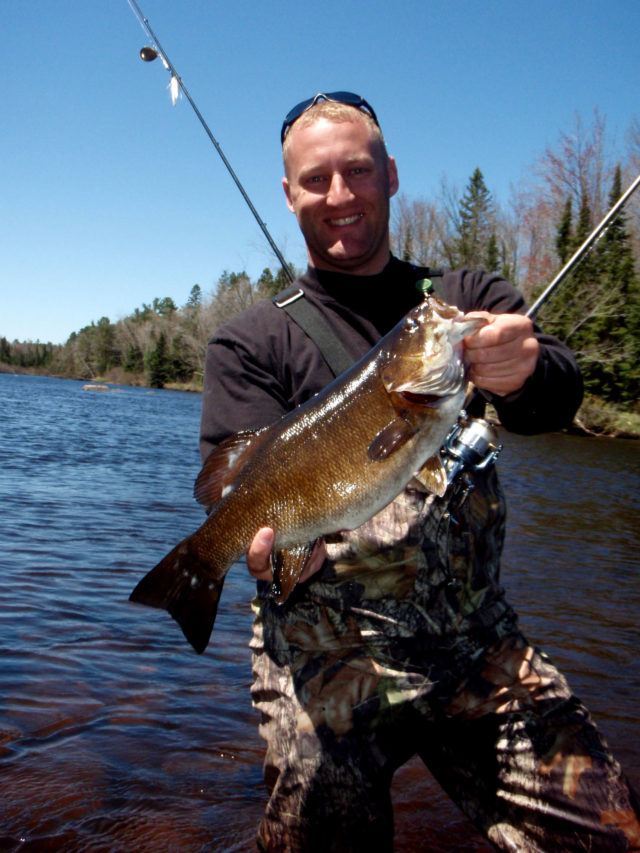
We are sometimes oblivious to the fact that small streams can be home to big smallies. They can be successfully fished by a number of activities that includes wading, shore fishing, kayak, canoe, or even small boat. Every once in a while, anglers who are as secretive as the small streams they’re fishing get lucky with monstrous bass.
An Inexpensive Adventure
Whether your objective is fishing by foot (wading and bank fishing), or fishing by small watercraft if navigable (kayak, canoe or jon boat), there is no shortage of fishing style. Each form of fishing can be done successfully, and rather inexpensively.
On most small river trips, I try to float as often as possible providing the stream is navigable and deep enough for my 14 foot flat bottom jon. I will float and cover large stretches of stream in combination with eventually wading its high-percentage locations while wearing a set of breathable waders. The same type of river fishing experience can also be done with a kayak. Fish from boat as often as you can as wading tends to spook fish. There will be times it becomes necessary however. Meanwhile, some small streams are simply too shallow or too narrow to offer any type of successful small craft fishing program. These waters are best fished by entirely wading and hiking them along its banks for miles.
However you decide to go about it, the biggest adventure and thrill seeking you will get from your efforts will be locating your river access (whether public or private), and exploring everything what lies around the bend. All rivers and streams are public as long as you keep within the original stream bed. Some shorelines and adjacent lands along them are private however. Make sure you have permission to be on any water that meanders through private land.
Equipping yourself for small stream combat with big bass is easy and inexpensive. Whether wading or floating, always strive to carry a bare minimum of gear. Travel light, but fish with a partner for safety and to help keep you engaged
When I used to fish small streams upwards of 50 times per season, I’d go through a new set of breathable waders or boots every other season. My wading equipment during that era wasn’t durable enough to withstand the wear and tear of my streams. Unlike other gear and tackle I will recommend for stream fishing, I don’t advise going cheap on waders and wading boots. Get the best quality pieces you can afford so each could potentially last longer than a few seasons of use. To date, I have had my best experiences with Cabela’s Guide Series wading pants, and Korkers footwear wading boots. Altogether, the setup could run between $200-300. Stream anglers might not find waders necessary, opting to wet wade instead. While it means well, that mindset will do you more harm than good. Wading boots will help prevent you from slipping on rocks and help avoid foot injury. Wading pants or suit will prevent you from catching waterborne illness and infections, and better yet keep you safe from poison ivy.
If you fish from kayak or small craft, it’s acceptable to carry a few multi-purpose rods in both casting and spinning set-ups. Meanwhile if wading, try your best to fish with only one rod that can universally fish the baits and lures you carry. It is possible to wade with a secondary rod strapped around your back or in a holster, but this will be a hindrance to your mobility and wading coordination. For my stream fishing, I’ve always fished best with a 6 and a half foot medium fast action spinning rod with a reel spooled with 6 lb. high abrasion-resistant copolymer line, or 15 lb. Cortland Masterbraid. With my single spinning setup I can jig and cast everything without issue, and it’s plenty strong to play smallmouth of all sizes. To help enhance your casting angles and accuracy within these smaller venues, you will want to fish shorter length rods.
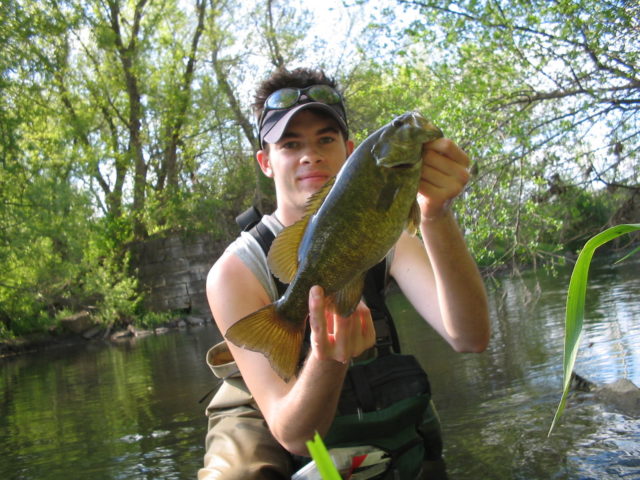
Adventuring and getting lost within small rivers and streams can be some of the best, rewarding, and affordable bass fishing there is. Throughout my boat-less high school and early college days, the small unpressured streams of Northern Illinois taught me the smallmouth game.
Less is More
Several baits excel in catching stream smallmouth. I like to carry a few baits that resemble their natural prey such as crayfish and minnow species that are natural to the stream that could include madtoms, sculpin, darters, chubs, shiners and suckers. Bring a combination of baits you can fish along bottom, and a selection you can fish above surface and near surface. All it takes is a couple of small Plano stowaways stuffed in a small fanny pack buckled around your waist, chest pack, backpack, or a satchel around your shoulders.
Softbaits are most popular and productive. 2 to 4” curly tail grubs such as a Kalins Lunker Grub, and Pradco Spring Grub are all time river favorites and available in crayfish and minnow patterns. Rigging simply with a 1/16 or 1/8 oz. jig head is deadly and effective. They can be fished while swimming with a slow to medium retrieve, and jigged along bottom. Always carry a handful of tails and heads because you are bound to lose more than a few. And whenever you do, it won’t break your bank.
If in need of a conversion bait (turning followers into biters), a 4” fluke, fluke jr., shad assassin, and baby slug-go glided through the pool with a weedless EWG worm hook, or on a lighter drop shot rig is the way to go. You’d be amazed how many fish this simple setup catches even when bass are piled up into holes.
Tube jigs and craw imitating plastics such as 3” YUM Crawbugs are universal river fishing favorites. On any river with crayfish as the main forage species, YUM Crawbugs often receive my preferential treatment. I rig up with jig head inserts, plain ball heads, and weedless 1/8 oz. Owner Weighted Worm Hook or Charlie Brewer Slider Heads. I allow my environment to determine which hook type to use.
Lets not forget hair jigs either. Smallmouth often favor the pulsating appeal of a hand tied marabou or bucktail jig that represents insects, leeches, and crayfish. Hair jigs have become popular in today’s bass fishing age but we all seem to forget their earliest origins were on small rivers and streams. My favorite stream fishing hair jigs are hand-tied by friends, Jim Gronaw of River Critter Hair Jigs in Westminster MD, and Jonn Graham of Warrior Jigs in Central IL.
Wherever streamflow allows, small size topwaters such as a Storm Chug Bug, Rapala Skitter Pop and X-Rap Pop, Yo-Zuri 3DB Pencil, and Heddon Tiny Torpedo fare best. Typically, these with usually be fished through current breaks and slackwater pools. Topwaters tend to catch the largest bass in the system.
Crankbaits are a proven smallmouth commodity. Where I see rocks and hard bottom pools, I pitch a small crank such as a Rebel Craw, or Bandit 100. Browns, oranges, and reds are best. Crankbaits can be effectively fished through current as well as deep holes. Retrieve quickly and erratically, banging and bouncing them to trigger strikes.
If casting equipment is your best option, give consideration to single Colorado and double willow spinnerbaits, swim jigs, and buzzbaits. With this approach, you will be targeting the largest fish of the stream.
Don’t make the common small stream mistake of over-downsizing baits, to the point of it becoming ultra-light micro fishing. Lures you would fish under normal situations will consistently catch smallmouth of all sizes, and more quality fish.
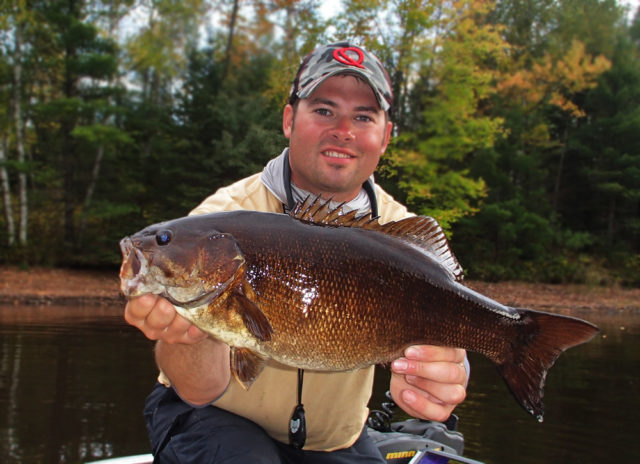
In some rare scenarios, small rivers may be navigable by small boat if they are tributaries and feeder creeks of much larger river systems. They are best fished by kayak, but shallow drafting hulls can get into them as well as I’ve frequently attempted with mine.
Keep Quiet
Many of the best small streams I’ve fished in urban and remote locations support healthy, productive bass fisheries. Their productiveness has usually been the result of inconvenient location and difficult access, their secretive nature, and lack of popularity and exposure. Do your best to protect and preserve their integrity.
Small streams with the biggest smallmouth are those that never get fished and visited by humans. They’re best to be kept secret for obvious reasons that include pressure, exploitation, overharvest, and pollution. Small streams simply cannot handle fishing pressure, and if big bass become harvested those specimens are irreplaceable and gone forever from the system. Most small streams, if any, are never stocked or managed.
People and fragile ecosystems never mix, but if you take advantage of the resource with the right frame of mind and keep information to yourself, you will enjoy its fishery for seasons to come. Apply some of these insights and strategies to your small stream adventures, and you can catch big smallmouth off the beaten path.


